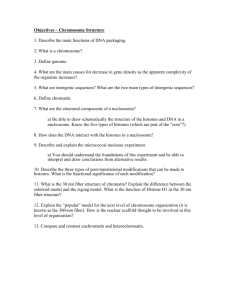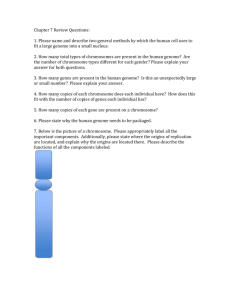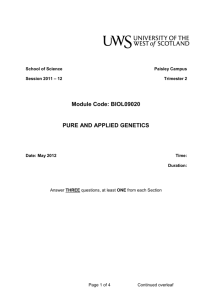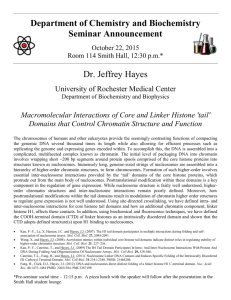Chapter 7 Review (Exam 2)
advertisement
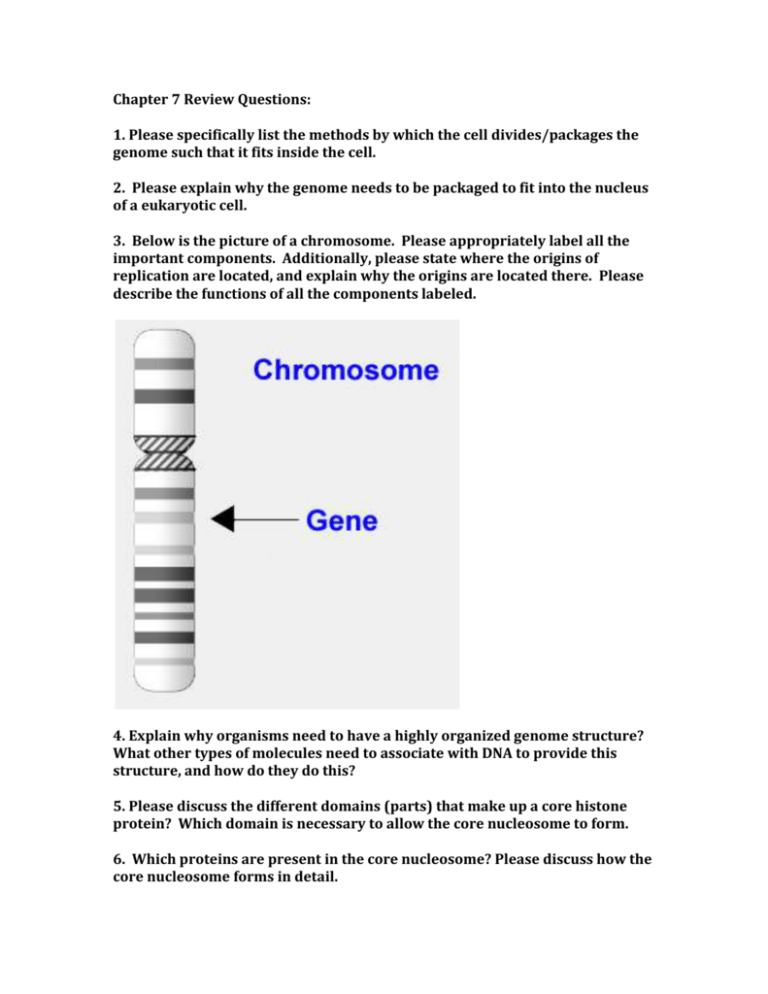
Chapter 7 Review Questions: 1. Please specifically list the methods by which the cell divides/packages the genome such that it fits inside the cell. 2. Please explain why the genome needs to be packaged to fit into the nucleus of a eukaryotic cell. 3. Below is the picture of a chromosome. Please appropriately label all the important components. Additionally, please state where the origins of replication are located, and explain why the origins are located there. Please describe the functions of all the components labeled. 4. Explain why organisms need to have a highly organized genome structure? What other types of molecules need to associate with DNA to provide this structure, and how do they do this? 5. Please discuss the different domains (parts) that make up a core histone protein? Which domain is necessary to allow the core nucleosome to form. 6. Which proteins are present in the core nucleosome? Please discuss how the core nucleosome forms in detail. 7. How many base pairs of DNA are wound around the core nucleosome? 8. What type of DNA is found between core nucleosomes? Which protein binds this DNA? 9. Please be as specific as you can in your answer. How many base pairs of DNA are wound into a nucleosome? Please discuss in detail an experiment that would determine this. 10. Please discuss the selenoid vs. the zig-zag model of chromatin structure. Which is physiologically relevant? Why (Please be detailed in your answer)? 11. Why is it sometimes important for the cell to change chromatin structure (winding of DNA). Please name three methods by which the cell uses to change chromatin structure. Choose one of these methods and explain how this method is used to change change chromatin structure. 12. Please briefly discuss the problem of why it is difficult to pack naked DNA into the nucleus of a Eukaryotic cell. 13. Assuming that the 30 nm fiber in humans is in the zig-zag conformation, please predict the appropriate conformation for the 30 nm fiber in the organisms below (Please note that less than 20 bp of linker DNA is considered short). 1. Oak Tree: 130 bp of linker DNA 2. Mouse: 17 bp of linker DNA 3. S. pombe (fission yeast): 12 bp of linker DNA 4. Drosophila: 22 bp of linker DNA 5. Elephant 54 bp of linker DNA 6. Shark 36 bp of linker DNA 14. Do each of the human chromosomes have the same number of genes. Please explain your answer. 15. What is the main difference between circular and linear genomes. Is one more stable than the other. Since genomes must be stable, how does the one with less stability solve this problem? 16. You are performing an experiment to determine the amount of DNA wound around the nucleosomes of the following organisms. Which enzyme would you use and why? Based on the data below, please state your conclusions, including how much DNA is protected by Histone H1. a. Frog-low concentration: bands in multiples of 160 bp Frog- high concentration: single band at 133 bp b. Chimpanzee-low concentration: bands in multiples of 180 bp Chimpanzee-high concentration: single band at 147 bp c. Crocodile- low concentration: bands in multiples of 170 bp Crocoldile-high concentration: single band at 138 bp 16. Please explain why having chromosomes is advantageous to organisms. 17. You are studying a gene located on chromosome 8 in the human genome called the X gene. The X gene has two variants, XA and XB. Homozygotes for the XB allele have X-disease. Please draw a picture depicting chromosome 8, showing the chromosomal content of those who will not develop X-disease. 18. Below is a picture of a chromosome please label the arms appropriately. 20. You wish to do an experiment in which you determine the amount of DNA wound around a nucleosome. Which experiment would you perform, and why? Please state what you could possibly learn from this experiment. 21. Please state three methods by which the cell can influence chromatin winding. Please explain how one of these methods works. 22. You are interested in studying expression of a certain gene in a number of cell types. Upon examination of your data you find that is expressed to the following levels in each cell type: a. epidermal cell: high b. neuron: low c. intestinal cell: high d. kerotinocyte: high e. vascular endothelial cell: low f. pancreatic cell: low Please state which type of chromatin your gene should be found in for each cell type. 23. Please describe in detail how histone acetylation affects chromatin winding. In the process of your description, please include the enzymes that are responsible for changing histone acetylation states.
